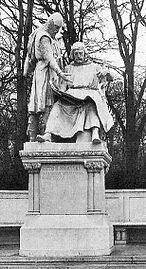Double statue
A double statue , also known as a double statue , is a special form of the statue and the group of figures that unite two (often equal) figures, usually on a common plinth or pedestal . This form of representation has been known since ancient times (cf. tetrarchs ). It has enjoyed greater popularity since classicism.
Examples

Group of princesses, plaster model (1795) in the Friedrichswerder Church in Berlin
Antiquity
- 2nd century: Ildefonso group from Hadrian times , was the model for later double statues
18th century
- 1767: The Dioscuri (Castor and Pollux) by Joseph Nollekens , Victoria and Albert Museum in London - see right
- 1795/1797: The Two Princesses of Johann Gottfried Schadow in Berlin - see right
19th century
- 1857: Goethe-Schiller monument in Weimar by Ernst Rietschel - see right
- 1899: Gauß Weber monument in Göttingen by Ferdinand Hartzer
- 1883: Reformation monument in Leipzig by Johannes Schilling (not preserved)
- 1889: Hutten-Sickingen monument below Ebernburg Castle , executed by the sculptors Robert and Ludwig Cauer based on plans by their father Karl
- 1891: War memorial 1870/71 in Angermünde with Kaiser Wilhelm I and Friedrich III. by Albert Manthe
- 1892: Monument in the Plaza de Isabel la Católica in Granada : Columbus submits his plans to Queen Isabella I of Castile
- 1896: Double statue in Duisburg OT Ruhrort of Emperor Wilhelm I and Reich Chancellor von Bismarck , in front of the Schifferbörse, by Gustav Eberlein (melted down in World War II)
- 1896: Brothers Grimm National Monument in Hanau
Brothers Grimm National Monument
in HanauMonument in the Plaza de Isabel la Católica in
Granada
20th century
- 1900: Double statue for the Brandenburg Margraves Johann I and Otto III, who ruled together . in monument group 5 on Siegesallee in Berlin by Max Baumbach
- 1900: Double statue of Kaiser Wilhelm I and Friedrich III. by Heinrich Wefing in Sorau (Niederlausitz) on the promenade at Wilhelmplatz (overthrown by French prisoners of war in 1945 and later eliminated)
- 1904: Double statue of Kaiser Wilhelm I and Friedrich III. by Johannes Pfuhl in the Upper Lusatian Hall of Fame in Görlitz , today Zgorzelec (destroyed in 1945 by the Polish authorities)
- 1909: Double statue of Johann Nikolaus von Dreyse and soldier ( Dreyse monument Sömmerda combined with a war memorial) in Sömmerda by Wilhelm Wandschneider (demolished in 1948, Dreyse's head fragment and base preserved)
- 1913: Double statue of Mephisto and Faust in the Mädlerpassage at the entrance to Auerbachs Keller in Leipzig by Mathieu Molitor
- 1939: Double statue "War and Peace" in Bleicherode by Gerhard Marcks , a memorial on the site of the former mining inspection for the fallen of the First World War and for the victims of labor
- 1986: Marx-Engels-Monument at the Marx-Engels-Forum in Berlin
Marx-Engels-Forum , Berlin
literature
- Ursula Zehm: The history of the double statue in German-speaking countries up to the 1st World War. With descriptive catalog , publishing house and database for the humanities (VDG), Weimar 1995, ISBN 3-929742-51-9 .
swell
- ↑ Arie Hartog: Teamwork against the spirit of the time. Some remarks on the memorial by Gerhard Marcks in Bleicherode ( online with photos ( memento of the original from January 11, 2016 in the Internet Archive ) Info: The archive link has been inserted automatically and has not yet been checked. Please check the original and archive link according to the instructions and then remove this notice. )
- ↑ The miners' association "Glückauf" and the double statue of Bleicherode ( online with photo )









